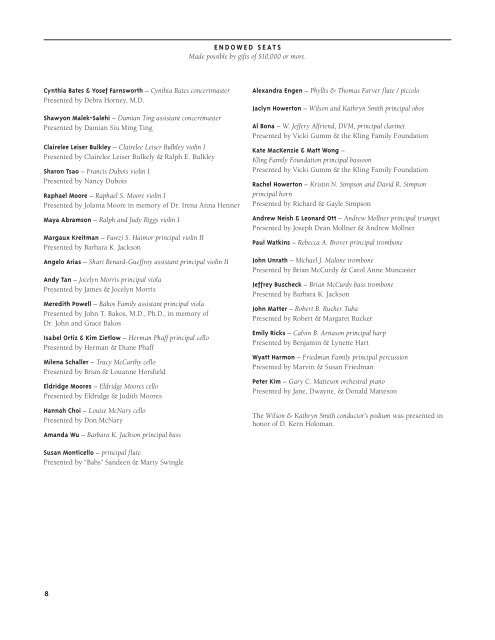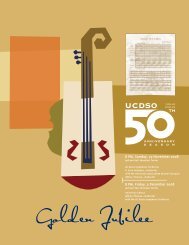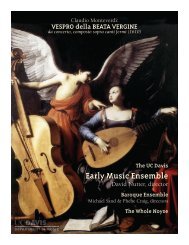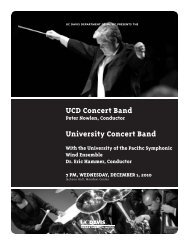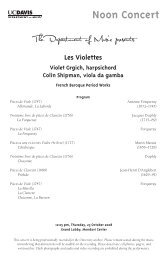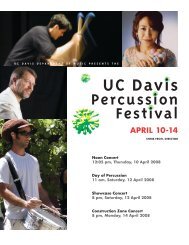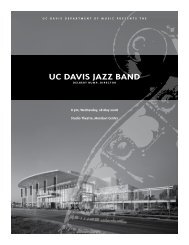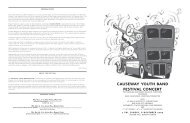Bruckner - UC Davis: Department of Music
Bruckner - UC Davis: Department of Music
Bruckner - UC Davis: Department of Music
You also want an ePaper? Increase the reach of your titles
YUMPU automatically turns print PDFs into web optimized ePapers that Google loves.
cynthia bates & yosef farnsworth – Cynthia Bates concertmaster<br />
Presented by Debra Horney, M.D.<br />
Shawyon malek-Salehi – Damian Ting assistant concertmaster<br />
Presented by Damian Siu Ming Ting<br />
clairelee leiser bulkley – Clairelee Leiser Bulkley violin I<br />
Presented by Clairelee Leiser Bulkely & Ralph E. Bulkley<br />
Sharon tsao – Francis Dubois violin I<br />
Presented by Nancy Dubois<br />
raphael moore – Raphael S. Moore violin I<br />
Presented by Jolanta Moore in memory <strong>of</strong> Dr. Irena Anna Henner<br />
maya abramson – Ralph and Judy Riggs violin I<br />
margaux kreitman – Fawzi S. Haimor principal violin II<br />
Presented by Barbara K. Jackson<br />
angelo arias – Shari Benard-Gueffroy assistant principal violin II<br />
andy tan – Jocelyn Morris principal viola<br />
Presented by James & Jocelyn Morris<br />
meredith powell – Bakos Family assistant principal viola<br />
Presented by John T. Bakos, M.D., Ph.D., in memory <strong>of</strong><br />
Dr. John and Grace Bakos<br />
isabel ortiz & kim Zietlow – Herman Phaff principal cello<br />
Presented by Herman & Diane Phaff<br />
milena Schaller – Tracy McCarthy cello<br />
Presented by Brian & Louanne Horsfield<br />
eldridge moores – Eldridge Moores cello<br />
Presented by Eldridge & Judith Moores<br />
hannah choi – Louise McNary cello<br />
Presented by Don McNary<br />
amanda wu – Barbara K. Jackson principal bass<br />
Susan monticello – principal flute<br />
Presented by “Babs” Sandeen & Marty Swingle<br />
8<br />
endowed SeatS<br />
Made possible by gifts <strong>of</strong> $10,000 or more.<br />
alexandra engen – Phyllis & Thomas Farver flute / piccolo<br />
Jaclyn howerton – Wilson and Kathryn Smith principal oboe<br />
al bona – W. Jeffery Alfriend, DVM, principal clarinet<br />
Presented by Vicki Gumm & the Kling Family Foundation<br />
kate mackenzie & matt wong –<br />
Kling Family Foundation principal bassoon<br />
Presented by Vicki Gumm & the Kling Family Foundation<br />
rachel howerton – Kristin N. Simpson and David R. Simpson<br />
principal horn<br />
Presented by Richard & Gayle Simpson<br />
andrew neish & leonard ott – Andrew Mollner principal trumpet<br />
Presented by Joseph Dean Mollner & Andrew Mollner<br />
paul watkins – Rebecca A. Brover principal trombone<br />
John unrath – Michael J. Malone trombone<br />
Presented by Brian McCurdy & Carol Anne Muncaster<br />
Jeffrey buscheck – Brian McCurdy bass trombone<br />
Presented by Barbara K. Jackson<br />
John matter – Robert B. Rucker Tuba<br />
Presented by Robert & Margaret Rucker<br />
emily ricks – Calvin B. Arnason principal harp<br />
Presented by Benjamin & Lynette Hart<br />
wyatt harmon – Friedman Family principal percussion<br />
Presented by Marvin & Susan Friedman<br />
peter kim – Gary C. Matteson orchestral piano<br />
Presented by Jane, Dwayne, & Donald Matteson<br />
The Wilson & Kathryn Smith conductor’s podium was presented in<br />
honor <strong>of</strong> D. Kern Holoman.<br />
noteS<br />
A<br />
Te Deum is a hymn <strong>of</strong> praise to God, to be sung at the dedication <strong>of</strong> a church, after a<br />
great military victory, for the coronation <strong>of</strong> monarchs, and at similar festivities. The<br />
test originated in the fifth century and is traditionally attributed to St. Ambrose.<br />
Since they are <strong>of</strong>ten wedged into windy affairs <strong>of</strong> state, Te Deums are usually brief, and<br />
<strong>Bruckner</strong>’s is, by <strong>Bruckner</strong>ian standards, positively compact. Nevertheless, it was summarily<br />
dismissed by the stodgy court conductor Joseph Hellmesberger, who had suggested the idea<br />
to begin with, as too long for the use <strong>of</strong> the Imperial Chapel.<br />
<strong>Bruckner</strong>’s Te Deum is in the regal key <strong>of</strong> C major and consists <strong>of</strong> five short movements<br />
played without pause. Much <strong>of</strong> the chorus material is in unison or counterpoint <strong>of</strong> childlike<br />
simplicity. There is a good deal <strong>of</strong> cross-referencing, especially in the many bright arpeggios<br />
and great tonic pedal points; moreover, the Te ergo and Salvum fac are, but for the test and<br />
distribution among the soloists, exactly the same. With that, indeed, the organization <strong>of</strong><br />
this quite minimal work is summarized: huge Gothic washes <strong>of</strong> chorus, brass, organ, and<br />
pealing eighth notes merely alternate with the gentler Te ergo and its mirror.<br />
Only in the last movement is there serious polyphony, and then it happens in a big way.<br />
In the simple introduction the test is declaimed for all to understand: “In Thee, O Lord,<br />
have I trusted that I shall not forever be confounded.” Afterward, a big double fugue breaks<br />
forth—two subjects at once; that is, here things are a little more complicated, but the point<br />
is that pairs <strong>of</strong> voices are answered by other pairs <strong>of</strong> voices. Church organists <strong>of</strong> the time<br />
were supposed to be able to write such things on demand, but <strong>Bruckner</strong>’s is an especially<br />
learned display. Everything seems to move at once, all the time. After the fugue dissipates, a<br />
homophonic version <strong>of</strong> the material prepares the way for return <strong>of</strong> the tremendous C-major<br />
effects from the very beginning.<br />
The Te Deum is a work <strong>of</strong> <strong>Bruckner</strong>’s steadfast faith, carrying his typical dedication “to<br />
the dear Lord.” Mahler scribbled in his own score his assessment <strong>of</strong> the performing force:<br />
“angelic tongues, Godseekers, tormented hearts and souls purified by flame.” <strong>Bruckner</strong> was<br />
more sanguine, suggesting that on the day he was to meet his maker, “I will show him the<br />
score <strong>of</strong> my Te Deum, and he may judge me accordingly.”<br />
—D. Kern Holoman<br />
By the time Gioachino Rossini was 21 years old, he had become the hero <strong>of</strong> Italian<br />
opera fans. And by the time he was 37 years old, he had composed 40 operas and<br />
had already retired from that part <strong>of</strong> his career. His tremendous and nearly<br />
unprecedented success as a child prodigy and young composer had already provided<br />
exceedingly rich experiences, so much so that he began an intentional hiatus from<br />
his public life as a celebrated composer – really a retirement, <strong>of</strong> sorts – that would<br />
ultimately last until his death more than 30 years later. While Rossini did not<br />
completely arrest his compositional interests, he composed no more opera after<br />
William Tell (1829) and chose religious themes for most <strong>of</strong> his subsequent works,<br />
leading to a few sacred cantatas, the Petite Messe Solennelle, and the Stabat Mater that<br />
was begun in 1831 but completed a decade later.<br />
Stabat Mater is a thirteenth-century text that recounts the suffering <strong>of</strong> Mary at the foot <strong>of</strong><br />
the cross during the crucifixion <strong>of</strong> Jesus. While settings <strong>of</strong> the Roman Catholic sequence,<br />
or liturgical poem, have come from the pens <strong>of</strong> composers worldwide, it is safe to say that<br />
more settings have been produced by Italian composers than those <strong>of</strong> any other nationality.<br />
Indeed, it has been a favorite text <strong>of</strong> Italian composers for centuries, and the setting by<br />
Giovanni Battista Pergolesi (1736) has enjoyed enormous popularity. Pergolesi wrote his<br />
setting during the last month <strong>of</strong> his life, and it was so immediately famous and successful<br />
that his reputation flourished in the years following his death, so much so that a number<br />
<strong>of</strong> compositions, all incorrectly (either intentionally or not) attributed to him, took hold for<br />
about 200 years as the product <strong>of</strong> the creator <strong>of</strong> the legendarily beautiful Stabat Mater.<br />
bruckner: te deum<br />
For soloists (SATB), chorus; flutes I-II,<br />
oboes I-II, clarinets I-II, bassoons I-II;<br />
horns I-IV, trumpets I-III,<br />
trombones I-III, tuba; timpani;<br />
organ; strings<br />
Composed 1881–84 in Vienna<br />
First performed 10 January, 1886,<br />
by the Vienna Gesellschaft der<br />
Musikfreunde, Hans Richter<br />
conducting. A performance with<br />
piano had been given in the<br />
Musikvereinsaal on May 2, 1885,<br />
<strong>Bruckner</strong> conducting.<br />
Published by Theodor Rattig<br />
(Vienna, 1885)<br />
Duration: about 25 minutes<br />
roSSini: Stabat mater<br />
For soloists (SATB), chorus; flutes I-II,<br />
oboes I-II, clarinets I-II, bassoons I-II;<br />
horns I-IV, trumpets I-II,<br />
trombones I-III; timpani; strings<br />
Composed 1831–41 in Paris<br />
First performed 7 January 1842,<br />
Théâtre Italien, Paris, Gaetano Donizetti<br />
conducting.<br />
Published by Troupenas (France, 1841)<br />
and B. Schott’s Sons (Germany, 1841)<br />
Duration: about 60 minutes<br />
9


